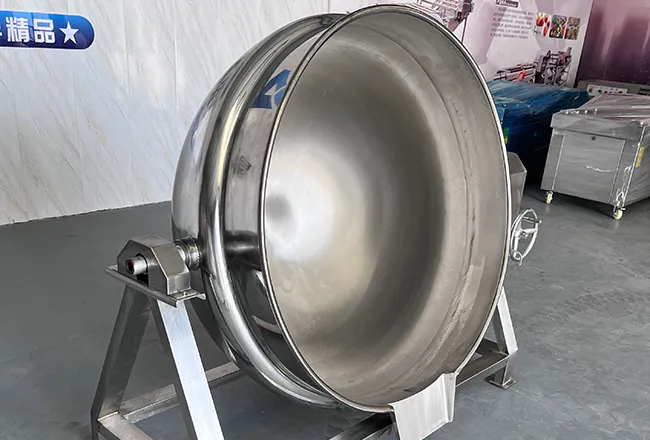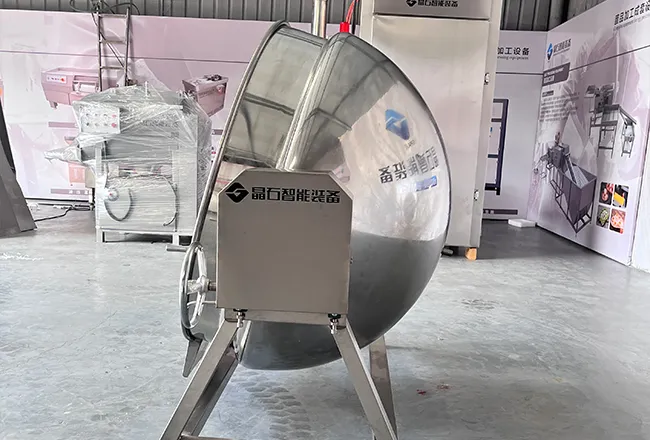Si votre demande n'est pas traitée dans les plus brefs délais, veuillez indiquer votre adresse WhatsApp/Skype dans le message, afin que nous puissions vous contacter dès la première fois.
Nous vous répondrons dans les 24 heures. En cas d'urgence, veuillez ajouter WhatsApp/WeChat : +8613573853927,. Ou appelez directement +8613573853927.
Food sticks, burns, and wastes money when you heat it in the wrong pot. Uneven steam or electric heating ruins sauce texture and throws HACCP plans off track.
A jacketed kettle uses a double-layer steam jacket (or electric jacket) to deliver uniform heating, letting processors cook, mix, and hold large quantities of product safely and efficiently.
I build and integrate kettles for meat plants, central kitchens, and ready‑meal lines. Let me show you how the right steam jacket kettle boosts yield, protects hygiene, and pays for itself fast—plus how to size, run, and maintain it.

Burnt bottoms hurt flavor and profit. A jacketed kettle solves that with even heating around the bowl instead of only from below.
The jacketed kettle, also known as a steam kettle or cooking kettle, is a widely used heating device in various industries such as food processing, chemical, and pharmaceutical sectors. In food processing, it is mainly used for cooking, simmering, concentrating, evaporating, and sterilizing operations. For example, jacketed kettles can be used to cook jams, boil syrups, stir-fry sauces, and braise meats. It is one of the common pieces of equipment found in kitchens and food processing factories.
Many tilting models include an agitator or scraper mixer to scrape the wall and keep high‑viscosity foods from sticking. Because kettles are available in a wide range of sizes—from 20 gallon countertop units to 500‑gallon stationary giants—you can match capacity to demand. In my plant projects, we often connect a steam generator or boiler for self-contained steam, or we specify an electric jacketed kettle when steam lines are not possible.
Many buyers mix up terms and end up with the wrong appliance. The differences matter when you plan piping and controls.
A steam jacket kettle has a sealed steam jacket around the bowl; a steam kettle may simply be heated by steam from below. The jacketed design gives better even heating and precise temperature control.

In practice, people say “steam kettle” when they mean “steam jacket kettle.” Cleveland, Groen, and Vulcan catalogs use both. What matters is the steam jacket wraps the bowl—this gives even heating and minimizes scorching. A “commercial steam kettle” might be a simpler, open-pot appliance heated by steam coils. If you want uniform heating and faster cook times, choose the full jacket.
| Modèle | Diamètre | Puissance de chauffage électrique | Surface de transfert de chaleur (㎡) | Huile caloporteuse | Dimensions globales (verticales) (mm) | Dimensions globales (inclinables) (mm) |
| Modèle 50 | 600mm | 9KW | 0.45 | 20 | 600*600*800 | 1100*750*900 |
| Modèle100 | 700mm | 18KW | 0.58 | 30 | 700*700*800 | 1200*880*900 |
| Modèle200 | 800mm | 18KW | 1.12 | 55 | 800*800*860 | 1400*1000*950 |
| Modèle300 | 900mm | 27KW | 1.42 | 65 | 900*900*900 | 1700*1300*1000 |
| Modèle 300 (avec agitateur) | 900mm | 27KW | 1.42 | 65 | 1000*1000*950 | 1800*1400*1100 |
| Modèle 400 | 1000mm | 27KW | 1.75 | 75 | 1100*1100*1000 | 1750*1450*1150 |
| Modèle 500 | 1100mm | 36KW | 2 | 120 | 1200*1200*1000 | 1900*1500*1200 |
| Modèle600 | 1200mm | 36KW | 2.3 | 160 | 900*900*900 | 1500*1200*1320 |
| Modèle 600 (avec agitateur) | 1200mm | 36KW | 2.3 | 160 | 1200*1200*1000 | 1700*1400*1450 |
| Modèle 800 | 1300mm | 36KW | 3.2 | 200 | 1300*1300*1100 | |
| Modèle 1000 (avec agitateur) | 1400mm | 45KW | 3.9 | 250 | 1400*1400*1200 | 1950*1600*1700 |
Thick sauces burn. Scrapers fix that. But not every product needs heavy agitation.
An agitator with a scraper blade keeps product moving and lets you scrape residue off the wall. Counter-rotating mixer arms handle high viscosity and ensure uniform heating.
I’ve seen operators try to cook jam without a scraper—result: black flecks and scrub time. A proper mixer with a scraper reduces scrub labor, improves even heating, and protects texture. For meat sauce, a counter-rotating agitator prevents clumping. For delicate soups, a gentle agitation prevents shear.
Terms to know:

An unclean kettle can undo all your sanitation work. Hygienic design is non‑negotiable.
Choose food-grade stainless steel, smooth welds, and easy-to-clean seams. Comply with HACCP by logging temperature, cleaning schedules, and preventing cross-contamination at filling and discharge.
We build kettles with SUS304 or 316 stainless steel plates and profiles. 316L stands up to low‑pH sauces. Rounded corners, removable scraper arms, and CIP spray balls make the kettle easy to clean. ASME specifications ensure safe pressurize ratings. During integration, I enforce “no dead leg” piping and documented sanitation: scrub, rinse, and final rinse water checks. A precise temperature control loop, plus log sheets, supports HACCP and food safety audits.
A great kettle alone doesn’t guarantee throughput. Integration matters.
Tie the kettle to upstream cutting/mixing and downstream filling. Use conveyors or pumps for hot filling, and integrate with meat mixers, vegetable washers, and packaging lines for true efficiency.
How is a jacketed kettle different from a regular pot used to cook?
A kettle has a steam jacket or electric jacket around the bowl for even heating, precise temperature control, and easier cleaning. A regular pot heats only from the bottom.
Can a jacketed kettle also be used as a steamer?
Yes. Many models function like a steamer by using steam in the jacket. Some include a perforated insert to steam vegetables or meat.
Do I need a boiler for a steam jacket kettle?
Not always. Some kettles are self-contained with a built-in steam generator. Electric heating is another option when boilers aren’t available.
What viscosity limits should I consider?
High-viscosity foods (jam, syrup, thick sauce) need strong agitation and scraper blades. Verify the motor torque and scraper design with the supplier.
Are kettles easy to clean?
Choose easy to clean designs: smooth welds, removable scraper arms, CIP spray balls, and stainless steel interior. That reduces scrub time and improves hygiene.
Can the kettle pressurize for faster cooking?
Some models can pressurize slightly to raise boiling temperature, but you must meet ASME specifications and safety codes.